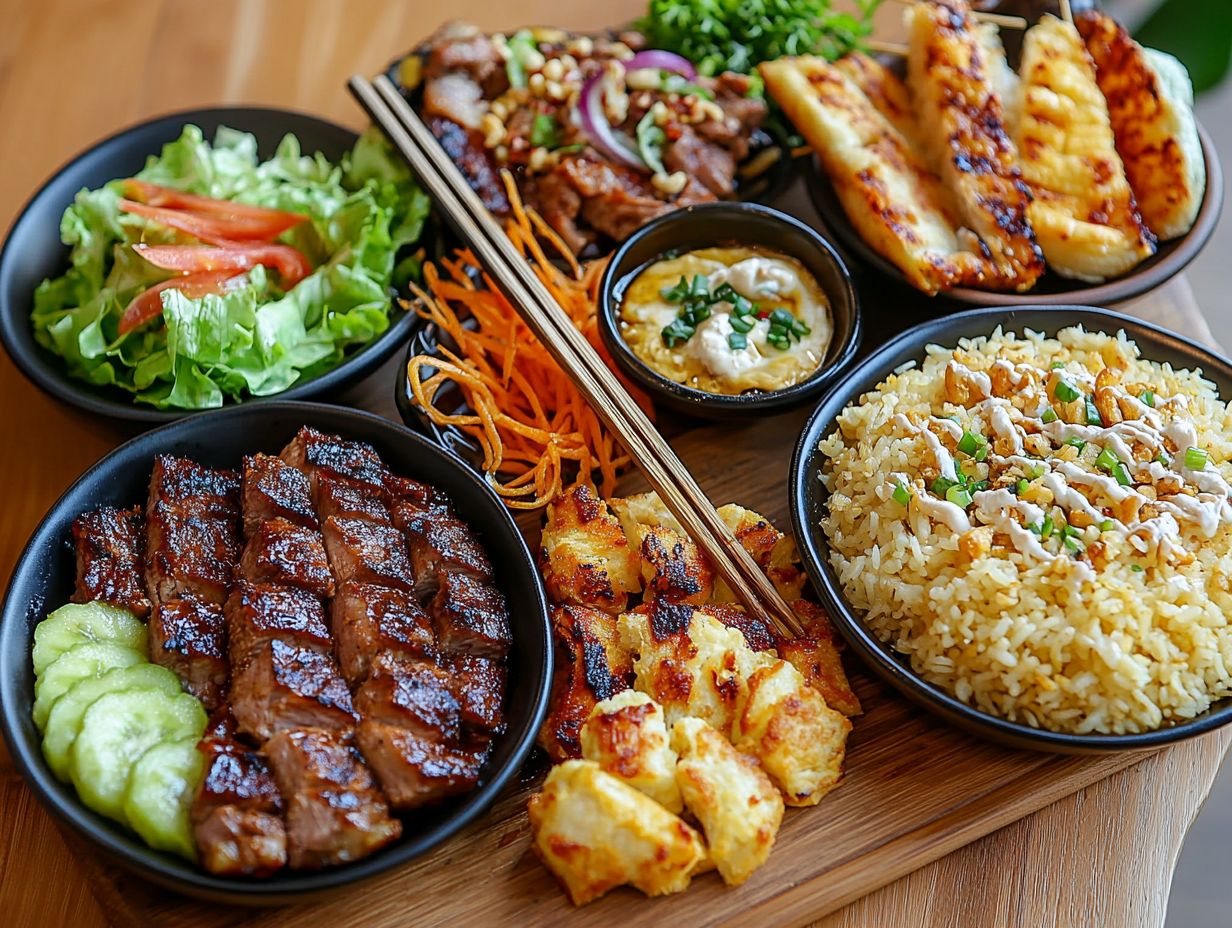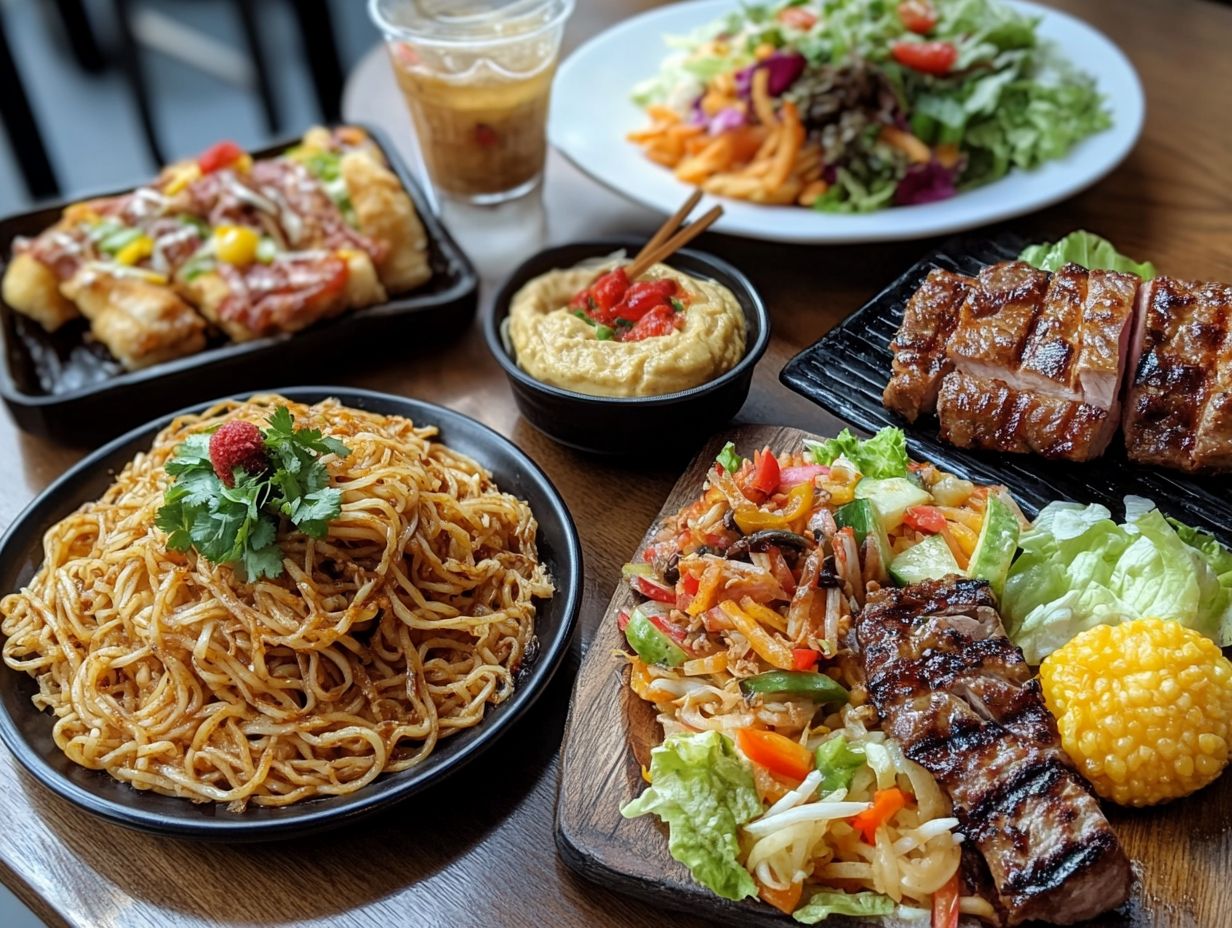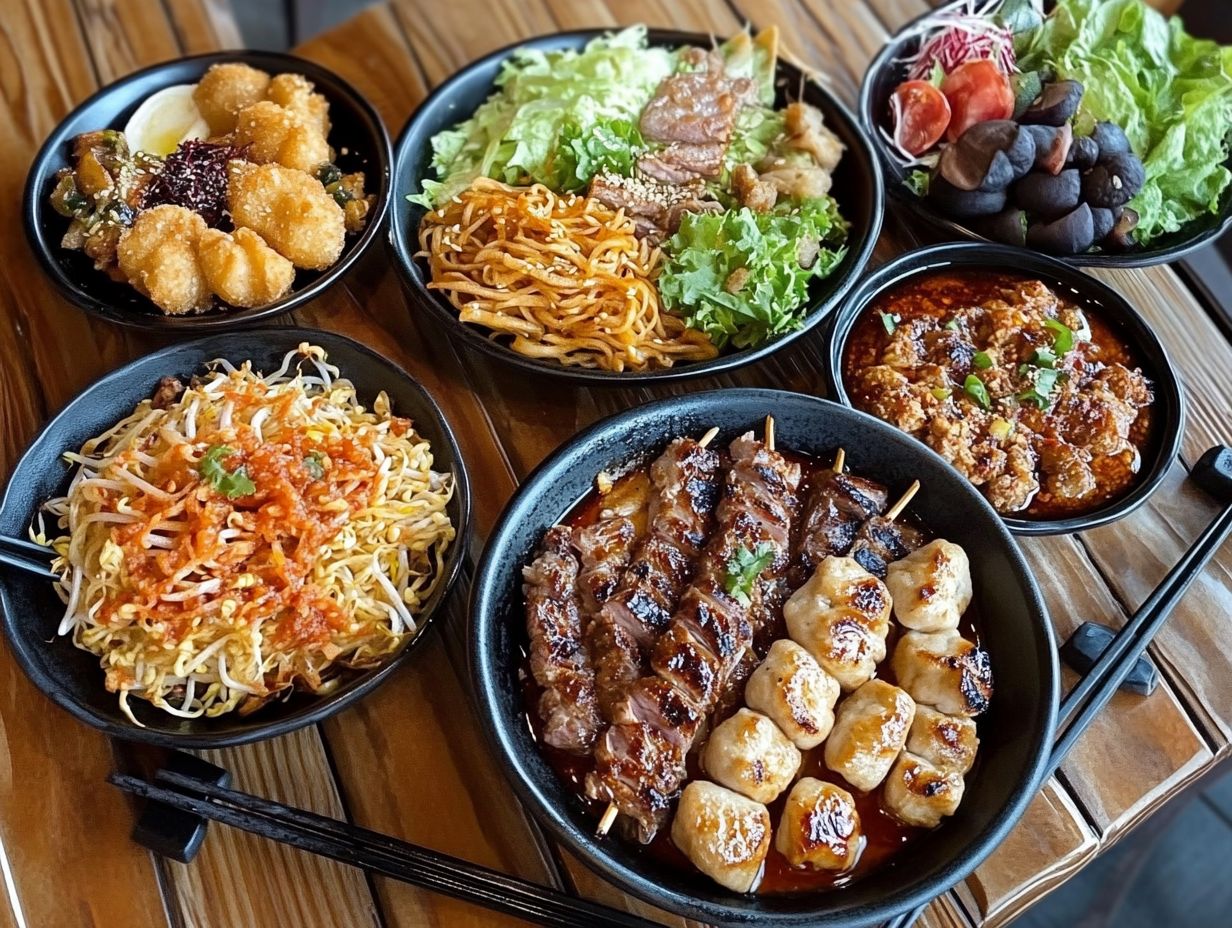5 Must-Try Local Dishes for Students Abroad
Embarking on a study abroad journey offers you more than just academic growth; it s a chance to fully immerse yourself in a new culture. What better way to do that than through its food?
This article delves into five must-try local dishes from around the globe. Imagine savoring savory empanadas from Argentina, fragrant pho from Vietnam, and hearty poutine from Canada.
You ll discover why indulging in local cuisine is crucial to your experience, how to uncover authentic dining spots, and tips for embracing flavors that may be unfamiliar to you.
Get ready to excite your taste buds while expanding your horizons!
Contents
- Key Takeaways:
- 1. Empanadas in Argentina
- 2. Pho in Vietnam
- 3. Burek in Bosnia and Herzegovina
- 4. Poutine in Canada
- 5. Pad Thai in Thailand
- Why Is Trying Local Food Important When Studying Abroad?
- Frequently Asked Questions
- What are the top 5 must-try local dishes for students studying abroad?
- Why are these dishes a must-try for students studying abroad?
- Where can I find these dishes while studying abroad?
- What makes paella in Spain a must-try dish?
- Is sushi in Japan different from sushi in other countries?
- Are these dishes suitable for vegetarians or those with dietary restrictions?
Key Takeaways:

- Expand your taste buds and cultural experience by trying traditional dishes like Argentina’s empanadas, Vietnam’s pho, and Bosnia and Herzegovina’s burek while studying abroad.
- Stepping out of your comfort zone and trying new foods can open doors to new cultural experiences and create unforgettable memories.
- To find authentic local food, students can ask locals for recommendations, visit local markets and street food stalls, and join food tours to fully immerse themselves in the culture.
1. Empanadas in Argentina
Empanadas are a key dish in Argentinian cuisine. They present flaky pastry filled with a delightful array of savory ingredients that truly capture the country s diverse cultural tapestry.
From spiced meats to a medley of cheese and vegetables, these flavorful pockets promise a culinary adventure for anyone visiting or studying in Argentina. You ll discover empanadas in various regional styles, each with its own unique ingredients and preparation techniques.
For example, the empanadas salte as from the northwest feature a slightly sweet dough and juicy, spiced fillings. Those hailing from Mendoza often boast hearty combinations of beef, olives, and hard-boiled eggs.
Shared meals hold immense significance in the Argentinian dining scene, fostering a sense of community and connection. Families gather around the table to savor these delectable treats, often paired with rich Malbec wines.
For students diving into the local culture, indulging in empanadas provides an excellent opportunity to engage with residents, transforming their study abroad experience into a rich tapestry of academic and sensory exploration.
2. Pho in Vietnam
Pho, the iconic Vietnamese noodle soup, captivates with its fragrant broth, tender meat, and fresh herbs, offering you a comforting taste of Vietnam that is essential for any culinary journey in the region.
Its origins date back to the early 20th century in northern Vietnam, where street vendors began to serve this delightful dish. As you traverse different areas, you’ll encounter regional variations that showcase local ingredients and tastes.
For example, Southern pho tends to be noticeably sweeter and is garnished with a broader selection of herbs and bean sprouts.
When savoring this exquisite soup, understanding dining etiquette accepted behavior during meals is key. This includes mastering the art of chopsticks and appreciating the significance of slurping.
Engaging with locals can elevate your experience, leading you to discover the most authentic street food vendors. They often serve variations that you won’t find in restaurants, enriching your appreciation for this beloved dish.
3. Burek in Bosnia and Herzegovina
Burek, with its sumptuous filling of meat or cheese, is not just a beloved pastry; it s your gateway into the rich tapestry of Bosnian cuisine and the diverse culinary traditions of Bosnia and Herzegovina.
With its flaky crust and savory filling, this dish transcends mere sustenance; it embodies cultural significance, often serving as a unifying force for families during festive occasions.
You ll find a myriad of variations, from spinach and cheese to pumpkin, each showcasing a unique twist that reflects local tastes and ingredients.
Crafting burek is truly a labor of love. It demands skill to achieve that perfect balance between a crispy exterior and a tender filling.
Many locals fondly recall learning this art from their grandmothers in lively kitchens, where laughter and storytelling mingled with the enticing aromas of sizzling spices.
For students exploring new horizons, sharing a plate of burek with local friends can transform into a delightful culinary adventure, fostering genuine connections and enriching their entire experience.
4. Poutine in Canada

Poutine is a quintessential Canadian comfort food. It features crispy fries topped with rich cheese curds and savory gravy. You must try it when exploring local cuisine.
Originating in rural Quebec in the late 1950s, poutine has since transformed into a myriad of regional variations. Each one reflects the unique food scene of Canada’s provinces. Whether you opt for the classic version or one of the innovative twists featuring ingredients like pulled pork or gourmet toppings, poutine embodies creativity while staying true to its hearty roots.
Poutine is also a cultural icon, often enjoyed in relaxed settings that promote communal dining. Imagine sharing trays of this mouthwatering dish with friends! Each bite offers a joyful celebration of togetherness.
5. Pad Thai in Thailand
Pad Thai is a quintessential Thai dish that features stir-fried noodles, shrimp, and peanuts. It tantalizes your taste buds and symbolizes a delightful fusion of local flavors that define Thai cuisine.
This culinary masterpiece showcases a harmonious blend of sweet, sour, salty, and savory tastes, making it a beloved choice for many. Traditionally prepared by street vendors, Pad Thai epitomizes the vibrant food culture in Thailand. You’ll find locals and tourists alike gathering around energetic stalls, captivated by the sizzling woks.
Each vendor adds their unique twist to the classic recipe, incorporating ingredients like tofu, bean sprouts, and lime. This allows you to savor distinct versions of this iconic dish.
Don’t miss the chance to taste Pad Thai, an essential part of your journey in Thailand. It serves as a delicious gateway into the country s rich culinary heritage and lively social scene.
Why Is Trying Local Food Important When Studying Abroad?
When you study abroad, trying local food isn’t just about satisfying your taste buds; it’s essential for immersing yourself in the cultural tapestry of your surroundings. It fosters connections with locals and allows you to explore diverse cuisines.
Food serves as a bridge, guiding you through cultural nuances and helping you forge friendships that enrich your experience. Sharing a meal with locals can ignite conversations about traditions, histories, and personal stories.
Culinary diversity introduces you to unique flavors and cooking methods. Each tells a tale about the people and places that gave rise to them. Engaging in local dining not only satisfies your cravings but enhances your student life by weaving together social ties and vibrant cultural exchanges. With every bite, you’re taking a step closer to understanding and appreciating your new home.
What Are Some Other Must-Try Local Dishes?
Beyond iconic dishes like empanadas and pho, you should dive into a treasure trove of must-try local cuisines. Each captures the unique flavors and ingredients of regions around the globe.
Imagine savoring Italy’s rich risotto, a luscious rice dish often kissed by saffron. Or indulge in Morocco’s tagine, where tender meat meets fragrant spices in a slow-cooked earthenware pot. If you’re feeling adventurous, don t miss Japan s umami-packed ramen, boasting a variety of broths and toppings that reflect the traditions of each region.
By embracing this culinary diversity, you unlock a realm of authentic experiences that go far beyond typical tourist fare. This allows you to forge connections with locals and their customs.
How Can Students Find Authentic Local Food?

Finding authentic local food while studying abroad is an exciting quest. It often involves recommendations from locals, exploring bustling street food markets, and discovering family-owned eateries. For more tips on this culinary adventure, check out Exploring Local Cuisine: A Student’s Guide.
To enhance this food journey, join guided food tours. They introduce you to a variety of delicious dishes and share insights into local food traditions.
Talking to locals can reveal amazing hidden spots you won t want to miss! Utilizing platforms like Instagram or food blogs can help you find trending eateries based on real-time experiences from fellow food lovers.
Understanding basic dining etiquette such as local customs and table manners can truly enrich your meals.
What Are the Benefits of Trying Local Dishes?
Trying local dishes while studying abroad offers numerous benefits. You gain enhanced cultural engagement, enriched social interactions, and a deeper appreciation for the diverse culinary traditions, such as exploring 5 must-visit parks for students abroad that shape regional identities.
When you explore regional flavors, you often find yourself immersed in stories of heritage and community. This adventurous spirit can lead to meaningful connections with locals who share your love for food.
Your food exploration fosters friendships rooted in a shared passion, creating memorable meals that become the backdrop for lively conversations and laughter.
Understanding local food traditions provides valuable insights into historical practices, agricultural techniques, and social values. Each bite is more than just taste; it s a glimpse into the unique cultures that define a place.
How Can Trying Local Food Enhance the Study Abroad Experience?
Engaging with local food is a transformative aspect of the study abroad experience. It offers you a unique chance to immerse yourself in the culture, broaden your perspectives, and create lasting memories through shared meals and culinary adventures.
Picture yourself wandering through vibrant markets overflowing with fresh produce or discovering quaint family-run eateries where each bite tells a story of tradition and community. One student shared how a local cooking class helped them connect with residents, learning not just recipes but the rich history behind each dish.
These culinary experiences forge connections that extend beyond the dinner table, granting you deeper insights into local customs and practices. As you sample regional specialties, you cultivate a sense of belonging, feeling more integrated into your host country while savoring flavors that remind you of your journey.
What Are Some Tips for Trying New and Unfamiliar Foods?
When you venture into the world of new and unfamiliar foods, enhancing your culinary experience is about keeping an open mind, embracing local food traditions, and letting your adventurous spirit guide your taste buds.
To ease into this thrilling culinary journey, start with milder flavors before diving into intense dishes. Asking locals about their favorite meals sparks intriguing conversations and reveals hidden gems you might overlook.
Being open to sharing meals with peers or locals can lead to unforgettable experiences and forge meaningful connections. This willingness to explore diverse cuisines broadens your palate and nurtures personal growth, giving you the power to navigate different cultural contexts with an open heart and mind.
Frequently Asked Questions

What are the top 5 must-try local dishes for students studying abroad?
- Paella in Spain
- Sushi in Japan
- Poutine in Canada
- Pho in Vietnam
- Fish and chips in the United Kingdom
These dishes are a must-try because they are delicious and reflect local culture. For students, adapting to local cuisine can enhance your experience and save money, so check out tips for students on how to enjoy these affordable options!
Why are these dishes a must-try for students studying abroad?
These dishes showcase the vibrant flavors of each country. Enjoying them is a great way to connect with local culture.
Where can I find these dishes while studying abroad?
You can find these dishes at local restaurants and street food vendors. Some universities even serve them in their dining halls!
What makes paella in Spain a must-try dish?
Paella is a famous Spanish rice dish filled with seafood and spices. It’s often enjoyed during family gatherings, making it a special treat!
Is sushi in Japan different from sushi in other countries?
Sushi in Japan is made with fresh, high-quality ingredients. It’s prepared in a traditional way that makes it a unique experience!
Are these dishes suitable for vegetarians or those with dietary restrictions?
Some of these dishes may contain meat or seafood. However, many restaurants offer vegetarian options, so be sure to communicate your dietary needs!






